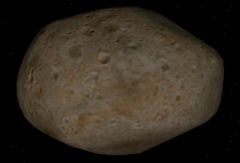Difference between revisions of "911 Agamemnon"
Jump to navigation
Jump to search
(Created page.) Tag: Removed redirect |
m (Arvil moved page User:Arvil/Sandbox02 to 911 Agamemnon: Move to article page.) |
(No difference)
| |
Latest revision as of 03:17, 27 October 2024
| 911 Agamemnon | |
|---|---|

| |
| 911 Agamemnon from Trojans.zip in Orbiter 2006P1 | |
| Designation | |
| Name | 911 Agamemnon |
| Reference body | Sun |
| Planetary mean orbits | |
| Epoch | 2009.46064339 |
| Semimajor axis (a) | 778417560353.55 m |
| Eccentricity (e) | 0.0669336622953245 |
| Inclination (i) | 4.5209495° (0.0789054541 radian) |
| Longitude of the ascending node (LAN, ☊) | 350.86468222558° (6.1237439338 radian) |
| Longitude of periapsis (ϖ) | 333.085997714023° (5.8134473524 radian) |
| Mean longitude (L) | 14.0461501186595° (0.2451515668 radian) |
| Selected physical parameters | |
| Mean radius | 75000 m |
| Mass | 2.6×1018 kg |
| Rotation elements | |
| SidRotPeriod | 44360 seconds (12.3222 hours) |
| SidRotOffset | 0 |
| Obliqutiy | 0 |
| LAN | 0 |
| Note | *Elements given are from 911 Agamemnon.cfg (Trojans.zip) |
911 Agamemnon (1919 FD, 1937 QD) is a large Jupiter Trojan asteroid of the Greek camp (whose orbits lie in the L4 point 60° ahead of Jupiter) and is suspected to be a binary asteroid. It was discovered by Karl Wilhelm Reinmuth at the Heidelberg-Königstuhl State Observatory in March 1919 and was named after the Greek King Agamemnon in the Iliad.
911 Agamemnon in Orbiter[edit]
911 Agamemnon was introduced to orbiter with the release of Trojans.zip add-on in June 2009.
| Add-on | Source | Version | Author | Type | Release Date | Compatibility | Wiki article |
|---|---|---|---|---|---|---|---|
| Trojan Asteroids v1.01 | O-F Resources | v1.01 | sputnik | Scenery | 27 June 2009 | ||
See also[edit]
Gallery[edit]
| edit The Solar System | |
|---|---|
| Central star |
Sun (Sol) |
| Planets |
Mercury - Venus - Earth - Mars - Jupiter - Saturn - Uranus - Neptune |
| Natural satellites |
Moon - Phobos - Deimos - Io - Europa - Ganymede - Titan - more... |
| Add-ons |
Planets - Dwarf Planets - Small objects - Natural satellites - Alternative star systems |
